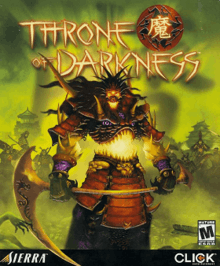Throne of Darkness
Throne of Darkness is a Japanese-themed action role-playing game released in 2001 by Sierra On-Line, a subsidiary of Vivendi Universal Interactive Publishing. Players control up to four (out of seven) different samurai at a time. The game has three separate multiplayer modes which support up to 35 players.
| Throne Of Darkness | |
|---|---|
 North American cover art | |
| Developer(s) | Click Entertainment |
| Publisher(s) | Sierra On-Line |
| Producer(s) | Mark Seibert |
| Designer(s) | D. Isaac Gartner Ben Haas |
| Programmer(s) | D. Isaac Gartner |
| Artist(s) | Ben Haas Victor Lee |
| Composer(s) | Etienne Grunenwald-Rohr Mark Hardy |
| Platform(s) | Microsoft Windows |
| Release | |
| Genre(s) | Action role-playing, hack and slash |
| Mode(s) | Single-player, multiplayer |
Plot
The game is set in Yamato, a medieval version of Japan ruled by the shogun Tsunayoshi and the daimyōs of the four clans. To become immortal, Tsunayoshi transforms himself into the demon Zanshin, the Dark Warlord, who unleashes his army of darkness to conquer Yamato. Zanshin's forces sweep across Yamato one night, catching the clans by surprise and annihilating them. However, believing that the four daimyōs were killed, Zanshin recalls his soldiers prematurely, leaving one daimyō and seven of his retainers alive. As dawn breaks, the daimyō decides to counterattack, ordering his seven surviving samurai to destroy Zanshin and his minions.
The four clans and daimyōs are named after historical Japanese clans and persons:
- The Mōri clan, led by daimyō Mōri Motonari.
- The Oda clan, led by daimyō Oda Nobunaga.
- The Tokugawa clan, led by daimyō Tokugawa Ieyasu.
- The Toyotomi clan, led by daimyō Toyotomi Hideyoshi.
Gameplay
Gameplay resembles Diablo II, as many of the game's developers worked on Diablo.[1]
Characters
The player chooses from seven different samurai: the Leader, the Archer, the Brick, the Ninja, the Wizard, the Swordsman, and the Berserker.
| Character | Mōri clan | Oda clan | Tokugawa clan | Toyotomi clan | Description |
| Leader | Takeda Shingen | Ōishi Kuranosuke | Date Masamune | Sanada Yukimura | The Leader is the most charismatic of the seven samurai, allowing him to purchase items and services at a discount. A jack-of-all-trades, he shares skills with many of the other samurai:
|
| Archer | Sasaki Kojirō | Teraoka Masami | Tejima Kenzaburo | Murakami Takauji | The Archer is the master of kyūdō and uses ranged weapons, including bow and arrow, shuriken, and kunai, but can also use a sword in close combat. |
| Brick | Sato no Tadanobu | Kamui Kanna | Musashibō Benkei | Akagi Toshiro | The strongest of the seven samurai, the Brick is an expert with polearms such as the naginata and tetsubo as well as being able to wield 1-2 swords. |
| Ninja | Ise Yoshimori | Kajiwara Kagesue | Ishikawa Goemon | Fujiwara Jutaro | A stealthy character, the Ninja is familiar with both the physical disciplines and magical arts of combat, allowing him to use swords and ranged weapons in addition to a knowledge of magical spells second only to the Wizard. |
| Wizard | Hōjō Sooun | Kawanabe Kyōsai | Sugawara no Michizane | Ootani Yoshitsugu | Physically the weakest of the samurai, the Wizard possesses a unique knowledge of wards, curses, and powerful elemental spells. He also has elementary training with a sword and ranged weapons. |
| Swordsman | Miyazaki Ashitaka | Imagawa Yoshimoto | Hōjō Ujimasa | Taira Kiyomori | The Swordsman is master of combat with the sword, as well as being formidable with a bow and arrow. |
| Berserker | Yagyū Jūbei | Nomi no Sukune | Hijikata Toshizō | Miyamoto Musashi | Skilled with polearms, 1-2 swords, as well as unarmed combat, the Berserker is unmatched at defeating large numbers of opponents. |
Reception
Blake Fischer reviewed the PC version of the game for Next Generation, rating it three stars out of five, and stated that "Fun but frustrating. Ultimately, the steep learning curve (formations? Don't even ask...) and increased micromanagement keep the game from being a "Diablo II killer.""[2]
Throne of Darkness was a finalist for The Electric Playground's 2001 "Best RPG for PC" award, but lost the prize to Arcanum: Of Steamworks and Magick Obscura.[3]
References
- Lafferty, Michael: A Click producer takes GameZone into the world of Throne of Darkness, GameZone, 2001. Archived 2006-12-05 at the Wayback Machine
- Fischer, Blake (December 2001). "Finals". Next Generation. Vol. 4 no. 12. Imagine Media. p. 115.
- Staff. "Blister Awards 2001". The Electric Playground. Archived from the original on October 13, 2003.